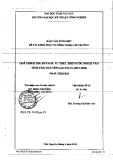
Hindawi Publishing Corporation
EURASIP Journal on Advances in Signal Processing
Volume 2011, Article ID 373205, 12 pages
doi:10.1155/2011/373205
Research Article
Analysis of the Sign Regressor Least Mean Fourth
Adaptive Algorithm
Mohammed Mujahid Ulla Faiz, Azzedine Zerguine (EURASIP Member),
and Abdelmalek Zidouri
Electrical Engineering Department, King Fahd University of Petroleum and Minerals, Dhahran 31261, Saudi Arabia
Correspondence should be addressed to Azzedine Zerguine, azzedine@kfupm.edu.sa
Received 25 June 2010; Accepted 5 January 2011
Academic Editor: Stephen Marshall
Copyright © 2011 Mohammed Mujahid Ulla Faiz et al. This is an open access article distributed under the Creative Commons
Attribution License, which permits unrestricted use, distribution, and reproduction in any medium, provided the original work is
properly cited.
A novel algorithm, called the signed regressor least mean fourth (SRLMF) adaptive algorithm, that reduces the computational cost
and complexity while maintaining good performance is presented. Expressions are derived for the steady-state excess-mean-square
error (EMSE) of the SRLMF algorithm in a stationary environment. A sufficient condition for the convergence in the mean of the
SRLMF algorithm is derived. Also, expressions are obtained for the tracking EMSE of the SRLMF algorithm in a nonstationary
environment, and consequently an optimum value of the step-size is obtained. Moreover, the weighted variance relation has been
extended in order to derive expressions for the mean-square error (MSE) and the mean-square deviation (MSD) of the proposed
algorithm during the transient phase. Computer simulations are carried out to corroborate the theoretical findings. It is shown that
there is a good match between the theoretical and simulated results. It is also shown that the SRLMF algorithm has no performance
degradation when compared with the least mean fourth (LMF) algorithm. The results in this study emphasize the usefulness of
this algorithm in applications requiring reduced implementation costs for which the LMF algorithm is too complex.
1. Introduction
Reduction in complexity of the least mean square (LMS)
algorithm has always received attention in the area of
adaptive filtering [1–3]. This reduction is usually done by
clipping either the estimation error or the input data, or
both to reduce the number of multiplications necessary at
each algorithm iteration. The algorithm based on clipping
of the estimation error is known as the sign error or more
commonly the sign algorithm (SA) [4–8], the algorithm
based on clipping of the input data is known as the sign
regressor algorithm (SRA) [9–12], and the algorithm based
on clipping of both the estimation error and the input data
is known as the sign sign algorithm (SSA) [13,14]. These
algorithms result in a performance loss when compared
with the conventional LMS algorithm [9,10]. However,
significant reduction in computational cost and simplified
hardware implementation can justify this poor performance
in applications requiring reduced implementation costs [15,
16].
The behavior of the SRA algorithm depends on the input
data. It is shown in [11] that for some inputs, the LMS
algorithm is stable while the SRA algorithm is unstable. This
is a drawback of the SRA algorithm when compared with the
SA algorithm since the latter is more stable than the LMS
algorithm [4,16]. The SRA algorithm is always stable when
the input data is Gaussian as in the case of speech processing.
Also, the performance of the SRA algorithm is superior to
that of the SA algorithm for Gaussian input data. It is shown
in [10] that the SRA algorithm is much faster than the SA
algorithm in achieving the desired steady-state mean-square
error for white Gaussian data. Theoretical studies of the SRA
algorithm with correlated Gaussian data in both stationary
and nonstationary environments are found in [12].
The convergence rate and the steady-state mean-square
error of the SRA algorithm is only slightly inferior to
those of the LMS algorithm for the same parameter setting.
In [10], the convergence rate of the SRA algorithm is
compared with that of the LMS algorithm to show that the
SRA algorithm converges slower than the LMS algorithm

2 EURASIP Journal on Advances in Signal Processing
by a factor of 2/π for the same steady-state mean-square
error.
It is shown in [17] that the SRA algorithm exhibits
significantly higher robustness against the impulse noise than
the LMS algorithm.
The above-mentioned advantages motivate us to analyze
the proposed sign regressor least mean fourth (SRLMF)
adaptive algorithm. In this paper, the mean-square analysis,
the convergence analysis, the tracking analysis, and the
transient analysis of the SRLMF algorithm are carried
out. The framework used in this work relies on energy
conservation arguments [18]. Expressions are evaluated for
the steady-state excess-mean-square error (EMSE) of the
SRLMF algorithm in a stationary environment. A condition
for the convergence of the mean behavior of the SRLMF
algorithm is also derived. Also, expressions for the tracking
EMSE in a nonstationary environment are presented. An
optimum value of the step-size µis also evaluated. Moreover,
an extension of the weighted variance relation is provided in
order to derive expressions for the mean-square error (MSE)
and the mean-square deviation (MSD) of the proposed
algorithm during the transient phase. From the simulation
results it is shown that both the SRLMF algorithm and
the least mean fourth (LMF) algorithm [19] have a similar
performance for the same steady-state EMSE. Moreover, the
results show that the theoretical and simulated results are in
good agreement.
The paper is organized as follows: following the Intro-
duction is Section 2 where the proposed algorithm is
developed, while the mean-square analysis of the proposed
SRLMF algorithm is presented in Section 3. The convergence
analysis of the proposed algorithm is presented in Section 4.
Section 5 presents the tracking analysis of the proposed algo-
rithm for random walk channels and as a by-product of this
analysis the optimum value of step-size for these channels
is derived. And Section 6 presents thoroughly the transient
analysis of the proposed algorithm. The Computational
Load is detailed in Section 7. To investigate the performance
of the proposed algorithm, several simulation results for
different scenarios are presented in Section 8. Finally, some
conclusions are given in Section 9.
2. Algorithm Development
The SRLMF algorithm is based on clipping of the regression
vector ui(row vector). Consider now the adaptive filter,
which updates its coefficients according to the following
recursion [18]:
wi=wi−1+µH[ui]u∗
ig[ei],i≥0, (1)
where wi(column vector) is the updated weight vector at
time i,µis the step-size, H[ui] is some positive-definite
Hermitian matrix-valued function of ui,g[ei]denotessome
function of the estimation error signal given by
ei=di−uiwi−1,(2)
where diis the desired signal. When the data is real-valued
and g[ei]=e3
i, the general update form in (1)becomes
wi=wi−1+µH[ui]uT
ie3
i,i≥0.(3)
Now if
H[ui]=diag1
ui1
,1
ui2
,...,1
uiM
,(4)
then the update form in (3)reducesto
wi=wi−1+µdiag1
ui1
,1
ui2
,...,1
uiM
uT
ie3
i
=wi−1+µsign [ui]Te3
i,i≥0,
(5)
where Mis the filter length. The SRLMF algorithm update
recursion in (5) can be regarded as a special case of the
general update form in (3) for some matrix data nonlinearity
that is implicitly defined by the following relation:
sign [ui]T=H[ui]uT
i.(6)
3. Mean-Square Analysis of
the SRLMF Algorithm
We wil assume that the data {di,ui}satisfy the following
conditions of the stationary data model [18,20–24].
(A.1) There exists an optimal weight vector wosuch that
di=uiwo+vi.
(A.2) The noise sequence viis independent and identically
distributed (i.i.d.) with variance σ2
v=E[|vi|2] and is
independent of ujfor all i,j.
(A.3) The initial condition w−1is independent of the zero
mean random variables {di,ui,vi}.
(A.4) The regressor covariance matrix is R=E[u∗
iui]>0.
For any adaptive filter of the form in (1), and for any
data {di,ui}, assuming filter operation in steady-state, the
following variance relation holds [18]:
µEui2
Hg2[ei]=2Eeaig[ei],asi−→ ∞ ,(7)
where
Eui2
H=EuiH[ui]uT
i,(8)
ei=eai+vi,(9)
and eai=ui(wo−wi−1) is the a priori estimation error. Then
g[ei]becomes
g[ei]=e3
i=eai+vie2
ai+v2
i+2eaivi.(10)
By using the fact that eaiand viare independent, we reach at
the following expression for the term E[eaig[ei]]:
Eeaig[ei]=3σ2
vEe2
ai+E
e4
ai.(11)

EURASIP Journal on Advances in Signal Processing 3
Ignoring third and higher-order terms of eai, then (11)
becomes
Eeaig[ei]≈3σ2
vEe2
ai.(12)
To evaluate the term E[ui2
Hg2[ei]], we start by noting that
g2[ei]=e6
ai+6e5
aivi+6eaiv5
i+15e4
aiv2
i+15e2
aiv4
i
+20e3
aiv3
i+v6
i.
(13)
If we multiply g2[ei]byui2
Hfrom the left, use the fact that
viis independent of both uiand eai, and again ignoring third
and higher-order terms of eai,weobtain
Eui2
Hg2[ei]≈6Eui2
Heaiv5
i+ 15Eui2
He2
aiv4
i
+E
ui2
Hv6
i
≈6Eui2
HeaiEv5
i+ 15Eui2
He2
ai
×Ev4
i+E
ui2
HEv6
i
≈6Eui2
HeaiEv5
i+ 15Eui2
He2
aiξ4
v
+E
ui2
Hξ6
v,
(14)
where ξ4
v=E[|vi|4], ξ6
v=E[|vi|6] denote the forth and
sixth-order moments of vi,respectively.
From Price’s theorem [25]wehave
Exsigny=2
π
1
σy
Exy,(15)
then
Eui2
H=Euisign [ui]T=2
πσ2
u
Tr(R).(16)
Substituting (16) into (14)weget
Eui2
Hg2[ei]≈6Eui2
HeaiEv5
i+ 15Eui2
He2
aiξ4
v
+2
πσ2
u
Tr(R)ξ6
v.
(17)
Substituting (12)and(17) into (7)weget
6σ2
vEe2
ai=µξ6
v2
πσ2
u
Tr(R)+15µξ4
vEui2
He2
ai
+6µEui2
HeaiEv5
i.
(18)
In order to simplify (18) and arrive at an expression for
the steady-state EMSE ζ=E[e2
ai], we consider two cases.
(1) Sufficiently Small Step-Sizes. Small step-sizes lead to
small values of E[e2
ai]andeaiin steady-state. Therefore, for
smaller values of µ, the last two terms in (18) can be ignored,
the steady-state EMSE is given by
ζ=µξ6
v
6σ2
v2
πσ2
u
Tr(R).(19)
(2) Separation Principle. For larger values of µ,weresort
to the separation assumption, namely, that at steady-state,
ui2
His independent of eai. In this case, the last term in (18)
will be zero since eaiis zero mean, the steady-state EMSE can
be shown to be
ζ=µξ6
v2/πσ2
uTr(R)
6σ2
v−15µξ4
v2/πσ2
uTr(R).(20)
4. Convergence Analysis of
the SRLMF Algorithm
Convergence analysis of the SRLMF algorithm is much more
complicated than that of the LMS algorithm due to existence
of the higher order estimation error signal in the coefficient
update recursion. We thus make the following assumptions
along with (A.2) to make the analysis mathematically more
tractable [19–24,26]:
(A.5) diand uiare zero-mean, wide-sense stationary, and
jointly Gaussian random variables.
(A.6) The input pair {di,ui}is independent of {dj,uj}for
all i,j.
Subtracting both sides of (5)fromwowe get
wi=wi−1+µsign [ui]Te3
i,(21)
where wi=wo−wi. Taking expectations of both sides of (21)
we obtain
E[wi]=E[wi−1]+µEsign [ui]Te3
i.(22)
Using Price’s theorem [25], we can conclude that
Esign [ui]Te3
i=2
πσ2
u
EuT
ie3
i.(23)
Substituting (23) into (22)weget
E[wi]=E[wi−1]+µ2
πσ2
u
EuT
ie3
i.(24)
The expectation E[uT
ie3
i] can be simplified using the fact that
for zero-mean and jointly Gaussian random variables x1and
x2,
Ex1x3
2=3E[x1x2]Ex2
2.(25)

4 EURASIP Journal on Advances in Signal Processing
Thus, using (25) in conjunction with (A.5), it follows that
EuT
ie3
i=EEuT
ie3
i|wi−1
=3EEe2
i|wi−1EEuT
iei|wi−1
=3Eσ2
e|wi−1EEuT
iei|wi−1,
(26)
where
Eσ2
e|wi−1=σ2
e−varE[ei|wi−1]
=σ2
e,
(27)
and from (9)
EEuT
iei|wi−1=EEuT
i(vi+uiwi−1)|wi−1
=EEuT
iuiwi−1|wi−1
=EuT
iuiwi−1
=RE[wi−1].
(28)
Substituting (27)and(28)in(26) yields
EuT
ie3
i=3σ2
eRE[wi−1].(29)
Substituting (29) into (24)weget
E[wi]=E[wi−1]+3µ2
πσ2
u
σ2
eRE[wi−1]
=I+3µ2
πσ2
u
σ2
eRE[wi−1].
(30)
Ultimately, it is easy to show that the mean behavior of the
weight vector, that is E[wi], converges to the optimal weight
vector woif µis bounded by:
0<µ< 2πσ2
u
3λmaxσ2
e
, (31)
where λmax represents the maximum eigenvalue of the
regressor covariance matrix R. Notice, that there exists the
time-varying function σ2
eand the regressor variance σ2
uin the
upper bound for µ. Since σ2
eis usually large at the beginning
of adaptation processes, we can see that the convergence
of the SRLMF algorithm strongly depends on the choice of
initial conditions.
5. Tracking Analysis of the SRLMF Algorithm
Here, we assume that the data {di,ui}satisfy the following
assumptions of the nonstationary data model [18].
(A.7) There exists a vector wo
isuch that di=uiwo
i+vi.
(A.8) The weight vector varies according to the random-
walk model wo
i=wo
i−1+qi, and the sequence qi
is i.i.d. with covariance matrix Q.Moreover,qiis
independent of {vj,uj}for all i,j.
(A.9) The initial conditions {w−1,wo
−1}are independent of
the zero mean random variables {di,ui,vi,qi}.
In this case, the following variance relation holds [18]:
µEui2
Hg2[ei]+µ−1Tr(Q)=2Eeaig[ei],asi−→ ∞ .
(32)
Tracking results can be obtained by inspection from the
mean-square results as there are only minor differences.
Therefore, by substituting (12)and(17) into (32), we get
6σ2
vEe2
ai=µ−1Tr(Q)+µξ6
v2
πσ2
u
Tr(R)
+15µξ4
vEui2
He2
ai
+6µEui2
HeaiEv5
i.
(33)
We again consider two cases for the evaluation of the tracking
EMSE ζof the SRLMF algorithm.
(1) Sufficiently Small Step-Sizes. Also, here, in this case we get
ζ=µ−1Tr(Q)+µξ6
v2/πσ2
uTr(R)
6σ2
v
.(34)
An optimum value of the step-size of the SRLMF algorithm
is obtained by minimizing (34)withrespecttoµ. Setting the
derivative of ζwith respect to µequal to zero gives
µopt =
Tr(Q)
2/πσ2
uTr(R)ξ6
v
.(35)
(2) Separation Principle. Similarly here as it was done for the
derivation of (20), we obtain the following:
ζ=µ−1Tr(Q)+µξ6
v2/πσ2
uTr(R)
6σ2
v−15µξ4
v2/πσ2
uTr(R), (36)
and eventually the optimum step-size of the SRLMF algo-
rithm is given by
µopt =
Tr(Q)⎡
⎣225ξ4
v2Tr(Q)
36σ2
v2ξ6
v2+1
2/πσ2
uTr(R)ξ6
v⎤
⎦
−15ξ4
v
6σ2
vξ6
v
Tr(Q).
(37)
6. Transient Analysis of the SRLMF Algorithm
Here, we will assume that the data {di,ui}satisfy the condi-
tions of the stationary data model described in Section 3.

EURASIP Journal on Advances in Signal Processing 5
6.1. Weighted Energy-Conservation Relation
Theorem 1. For any adaptive filter of the form (1),any
positive-definite Hermitian matrix Σ,andforanydata{di,ui},
it holds that [18]:
ui2
HΣH
wi
2
Σ+
eHΣ
ai
2=ui2
HΣH
wi−1
2
Σ+
eHΣ
pi
2,
(38)
where eHΣ
aiuiH[ui]Σwi−1,eHΣ
piuiH[ui]Σwi,andui2
HΣH=
ui(H[ui]ΣH[ui])u∗
i.
Proof. Let us consider the adaptive filter updates of the
generic form given in (1). Subtracting both sides of (1)from
wo,weget
wi=wi−1−µH[ui]u∗
ig[ei].(39)
If we multiply both sides of (39)byuiH[ui]Σfrom the left,
we get
eHΣ
pi=eHΣ
ai−µui2
HΣHg[ei].(40)
Two cases can be considered here.
Case 1 (ui2
HΣH=0). In this case, wi=wi−1and eHΣ
ai=eHΣ
pi
so that wi2
Σ=wi−12
Σand |eHΣ
ai|2=|eHΣ
pi|2.
Case 2 (ui2
HΣH/
=0). In this case, we use (40)tosolvefor
g[ei],
g[ei]=1
µui2
HΣHeHΣ
ai−eHΣ
pi.(41)
Substituting (41) into (39), we get
wi=wi−1−H[ui]u∗
i
ui2
HΣHeHΣ
ai−eHΣ
pi.(42)
Expression (42) can be rearranged as
wi+H[ui]u∗
i
ui2
HΣH
eHΣ
ai=wi−1+H[ui]u∗
i
ui2
HΣH
eHΣ
pi.(43)
Evaluating the energies of both sides of (43) results in
wi+H[ui]u∗
i
ui2
HΣH
eHΣ
ai
2
Σ=
wi−1+H[ui]u∗
i
ui2
HΣH
eHΣ
pi
2
Σ
.(44)
After a straightforward calculation, the following weighted
energy-conservation results:
wi
2
Σ+1
ui2
HΣH
eHΣ
ai
2=
wi−1
2
Σ+1
ui2
HΣH
eHΣ
pi
2.
(45)
The weighted energy-conservation relation in (45) can also
be written as
ui2
HΣH
wi
2
Σ+
eHΣ
ai
2=ui2
HΣH
wi−1
2
Σ+
eHΣ
pi
2.
(46)
6.2. Weighted Variance Relation. Here, the weighted variance
relation presented in [18] has been extended in order to
derive expressions for the MSE and the MSD of the SRLMF
algorithm during the transient phase.
Theorem 2. For any adaptive filter of the form (1),any
positive-definite Hermitian matrix Σ,andforanydata{di,ui},
it holds that
E
wi
2
Σ=E
wi−1
2
Σ+µ2Eui2
HΣH
g[ei]
2
−2µReEeHΣ∗
aig[ei],as i−→ ∞ .
(47)
Similarly, for real-valued data, the above weighted variance
relation becomes
E
wi
2
Σ=E
wi−1
2
Σ+µ2Eui2
HΣHg2[ei]
−2µEeHΣ
aig[ei],asi−→ ∞ .
(48)
Proof. Squaring both sides of (40), we get
eHΣ
pi
2=
eHΣ
ai−µui2
HΣHg[ei]
2.(49)
For compactness of notation let us omit the argument of g so
that (49)lookslike
eHΣ
pi
2=
eHΣ
ai
2+µ2ui4
HΣH
g
2−µeHΣ
aiui2
HΣHg∗
−µeHΣ∗
aiui2
HΣHg.
(50)
Substituting (50) into (46), we get
ui2
HΣH
wi
2
Σ=ui2
HΣH
wi−1
2
Σ+µ2ui4
HΣH
g
2
−µeHΣ
aiui2
HΣHg∗−µeHΣ∗
aiui2
HΣHg.
(51)
Dividing both sides of (51)byui2
HΣH(of course here
ui2
HΣH/
=0) we get
wi
2
Σ=
wi−1
2
Σ+µ2ui2
HΣH
g
2−µeHΣ
aig∗−µeHΣ∗
aig.
(52)
Taking expectations of both sides of (52), we obtain
E
wi
2
Σ=E
wi−1
2
Σ+µ2Eui2
HΣH
g[ei]
2
−µEeHΣ
aig[ei]∗+eHΣ∗
aig[ei],
(53)
or in the following format:
E
wi
2
Σ=E
wi−1
2
Σ+µ2Eui2
HΣH
g[ei]
2
−2µReEeHΣ∗
aig[ei],asi−→ ∞ .
(54)
For real-valued data, the weighted variance relation in (54)
becomes
E
wi
2
Σ=E
wi−1
2
Σ+µ2Eui2
HΣHg2[ei]
−2µEeHΣ
aig[ei],asi−→ ∞ .
(55)



![Báo cáo seminar chuyên ngành Công nghệ hóa học và thực phẩm [Mới nhất]](https://cdn.tailieu.vn/images/document/thumbnail/2025/20250711/hienkelvinzoi@gmail.com/135x160/47051752458701.jpg)






















